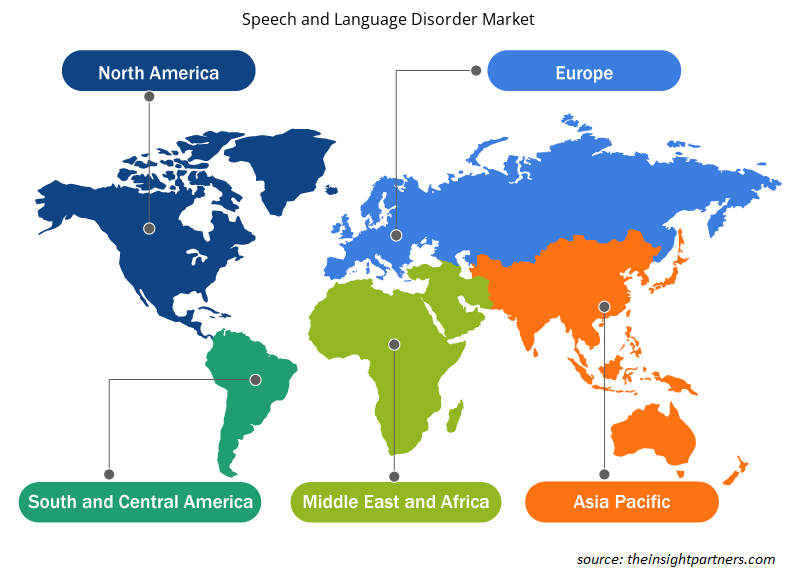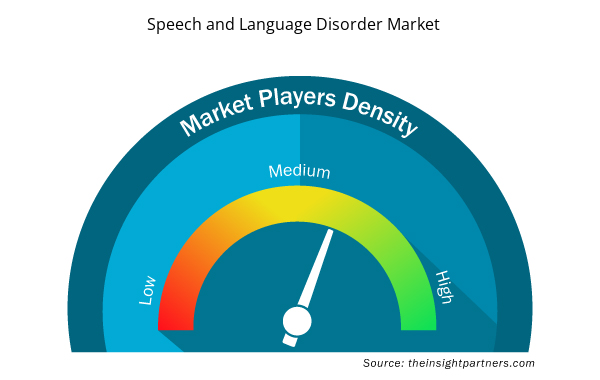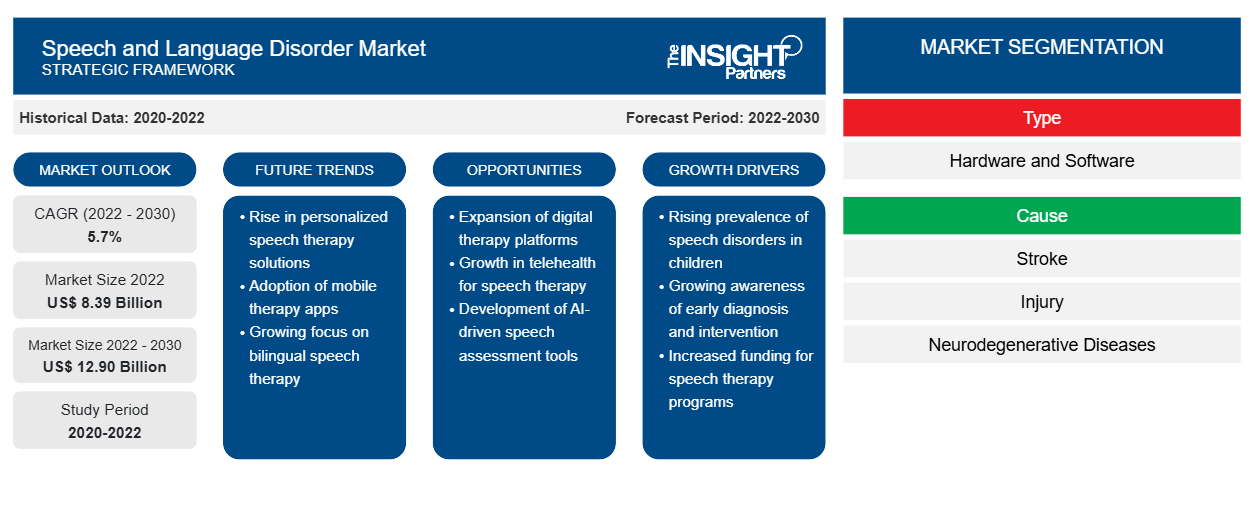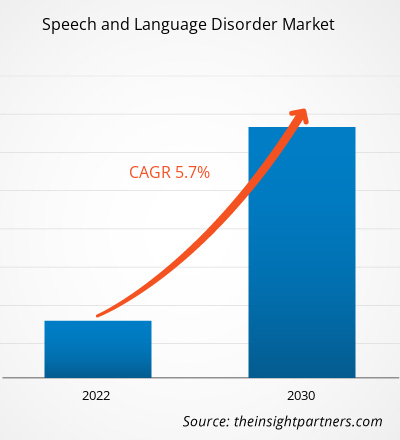[Forschungsbericht] Der Markt für Sprach- und Sprechstörungen soll von 8,39 Milliarden US-Dollar im Jahr 2022 auf 12,90 Milliarden US-Dollar im Jahr 2030 anwachsen. Für den Zeitraum 2022–2030 wird eine durchschnittliche jährliche Wachstumsrate (CAGR) von 5,7 % erwartet.
Markteinblicke und Analystenansichten:
Bei einer Sprachstörung hat der Patient Probleme, bestimmte Laute zu bilden oder zu erzeugen, die für eine einfache Kommunikation mit anderen erforderlich sind. Bei einer Sprachstörung hingegen kann die Person die Botschaft oder Bedeutung, die die andere Person vermitteln möchte, nicht verstehen oder hat Schwierigkeiten, ihre Gedanken richtig auszudrücken. Sprach- und Sprechstörungen können manchmal aufgrund von Verhaltens- oder emotionalen Störungen auftreten. Obwohl diese Störungen in entwickelten Teilen der Welt mit verschiedenen Therapien behandelt werden, herrscht in unterentwickelten oder abgelegenen Gebieten ein erheblicher Mangel an medizinischem Fachpersonal, was das Wachstum des Marktes für Sprach- und Sprechstörungen behindert.
Wachstumstreiber und Herausforderungen:
Die zunehmende Verbreitung von Sprach- und Sprechstörungen sowie die steigende Zahl neurodegenerativer Erkrankungen und Schlaganfälle treiben das Marktwachstum im Bereich Sprach- und Sprechstörungen voran. Laut den von der Stuttering Foundation veröffentlichten Daten stottern mehr als 80 Millionen Menschen oder 1 % der gesamten Weltbevölkerung. Der gleichen Quelle zufolge stottern etwa 5 % aller Kinder etwa 6 Monate oder länger, und etwa 1 % dieser Kinder stottern über einen längeren Zeitraum hinaus als durchschnittlich.
Darüber hinaus beträgt die Prävalenz von Sprachstörungen wie Artikulationsstörungen und phonologischen Störungen laut dem National Institute on Deafness and Other Communication Diseases bei Kleinkindern etwa 8–9 %, und etwa 3,3 % aller US-Kinder im Alter zwischen 3 und 17 Jahren haben Sprachstörungen. Die weltweit zunehmende Verbreitung von Sprach- und Sprechstörungen wie Artikulationsstörungen, phonologischen Störungen und Stottern treibt also das Marktwachstum voran. Darüber hinaus wird erwartet, dass der Einsatz künstlicher Intelligenz für die Sprach- und Sprechtherapie in den kommenden Jahren neue Markttrends für Sprach- und Sprechstörungen mit sich bringen wird .
Passen Sie diesen Bericht Ihren Anforderungen an
Sie erhalten kostenlos individuelle Anpassungen an jedem Bericht, einschließlich Teilen dieses Berichts oder einer Analyse auf Länderebene, eines Excel-Datenpakets sowie tolle Angebote und Rabatte für Start-ups und Universitäten.
- Holen Sie sich die wichtigsten Markttrends aus diesem Bericht.Dieses KOSTENLOSE Beispiel umfasst eine Datenanalyse von Markttrends bis hin zu Schätzungen und Prognosen.
Berichtssegmentierung und -umfang:
Die Marktanalyse für Sprach- und Sprechstörungen wurde unter Berücksichtigung der folgenden Segmente durchgeführt: Typ, Ursachen, Störungstyp, Altersgruppe, Anbieter und Geografie. Nach Typ ist der Markt in Hardware und Software unterteilt. Das Softwaresegment ist weiter in webbasiert und appbasiert unterteilt. Basierend auf der Ursache ist der Markt in Schlaganfall, Verletzung, neurodegenerative Erkrankungen und andere unterteilt. Das Segment der neurodegenerativen Erkrankungen ist weiter unterteilt in amyotrophe Lateralsklerose, Parkinson-Krankheit und Huntington-Krankheit. Basierend auf dem Störungstyp ist der Markt in Artikulationsstörungen, phonologische Störungen, Stimmstörungen oder Resonanzstörungen, Sprachstörungen und andere unterteilt.
Basierend auf der Kategorie ist der Markt in Erwachsene und Kinder unterteilt. Der Markt ist nach Anbietern in Gesundheitseinrichtungen, Sprachtherapiezentren, Rehabilitationszentren und andere unterteilt. Geografisch ist der Umfang des Marktberichts zu Sprach- und Sprachstörungen hauptsächlich in Nordamerika (USA, Kanada und Mexiko), Europa (Spanien, Großbritannien, Deutschland, Frankreich, Italien und der Rest von Europa), Asien-Pazifik (Südkorea, China, Japan, Indien, Australien und der Rest des Asien-Pazifik-Raums), Naher Osten und Afrika (Südafrika, Saudi-Arabien, die Vereinigten Arabischen Emirate und der Rest des Nahen Ostens und Afrikas) und Süd- und Mittelamerika (Brasilien, Argentinien und der Rest von Süd- und Mittelamerika) unterteilt.
Segmentanalyse:
Der Markt für Sprach- und Sprechstörungen ist nach Typ in Hardware und Software unterteilt. Im Jahr 2022 hielt das Softwaresegment einen größeren Marktanteil und wird voraussichtlich zwischen 2022 und 2030 eine höhere CAGR verzeichnen.
Basierend auf den Ursachen ist der Markt in Schlaganfall, Verletzung, neurodegenerative Erkrankungen und andere unterteilt. Das Segment der neurodegenerativen Erkrankungen ist weiter unterteilt in Parkinson-Krankheit, ALS und Huntington-Krankheit. Im Jahr 2022 hatte das Schlaganfallsegment den größten Marktanteil bei Sprach- und Sprechstörungen. Das Segment der neurodegenerativen Erkrankungen wird voraussichtlich zwischen 2022 und 2030 die höchste durchschnittliche jährliche Wachstumsrate verzeichnen.
Basierend auf der Art der Störung ist der Markt in Artikulationsstörungen, phonologische Störungen, Stimmstörungen oder Resonanzstörungen, Sprachstörungen und andere unterteilt. Im Jahr 2022 hielt das Segment Artikulationsstörungen den größten Marktanteil am Markt für Sprach- und Sprechstörungen. Es wird jedoch erwartet, dass dasselbe Segment zwischen 2022 und 2030 die höchste durchschnittliche jährliche Wachstumsrate verzeichnet.
Der Markt für Sprach- und Sprechstörungen ist nach Kategorie in Erwachsene und Kinder unterteilt. Im Jahr 2022 hatte das Segment Kinderheilkunde einen größeren Marktanteil und wird voraussichtlich zwischen 2022 und 2030 eine höhere durchschnittliche jährliche Wachstumsrate verzeichnen.
Der Markt ist nach Anbietern in Gesundheitseinrichtungen, Sprachtherapiezentren, Rehabilitationszentren und andere unterteilt. Im Jahr 2022 hatte das Segment Gesundheitseinrichtungen den größten Marktanteil im Bereich Sprach- und Sprechstörungen und wird voraussichtlich zwischen 2022 und 2030 die höchste durchschnittliche jährliche Wachstumsrate verzeichnen.
Regionale Analyse:
Geografisch ist der Markt in Nordamerika, Europa, Asien-Pazifik, den Nahen Osten und Afrika sowie Süd- und Mittelamerika unterteilt. Nordamerika leistet den größten Beitrag zum globalen Markt für Sprach- und Sprechstörungen. Es wird prognostiziert, dass der asiatisch-pazifische Raum zwischen 2022 und 2030 die höchste durchschnittliche jährliche Wachstumsrate (CAGR) auf dem Markt aufweisen wird. Nordamerika hatte 2022 den größten Anteil am Weltmarkt aufgrund der zunehmenden Fälle neurodegenerativer Erkrankungen, der zunehmenden Nutzung appbasierter Sprachtherapie, der zunehmenden Verbreitung von Sprachstörungen wie Unflüssigkeit und der Präsenz wichtiger Marktteilnehmer. In Nordamerika hatten die USA 2022 den größten Marktanteil.
Regionale Einblicke in den Markt für Sprach- und Sprachstörungen
Die regionalen Trends und Faktoren, die den Markt für Sprach- und Sprachstörungen während des Prognosezeitraums beeinflussen, wurden von den Analysten von Insight Partners ausführlich erläutert. In diesem Abschnitt werden auch die Marktsegmente und die Geografie für Sprach- und Sprachstörungen in Nordamerika, Europa, im asiatisch-pazifischen Raum, im Nahen Osten und Afrika sowie in Süd- und Mittelamerika erörtert.

- Erhalten Sie regionale Daten zum Markt für Sprach- und Sprachstörungen
Umfang des Marktberichts zu Sprach- und Sprachstörungen
| Berichtsattribut | Details |
|---|---|
| Marktgröße im Jahr 2022 | 8,39 Milliarden US-Dollar |
| Marktgröße bis 2030 | 12,90 Milliarden US-Dollar |
| Globale CAGR (2022 - 2030) | 5,7 % |
| Historische Daten | 2020-2022 |
| Prognosezeitraum | 2022–2030 |
| Abgedeckte Segmente | Nach Typ
|
| Abgedeckte Regionen und Länder | Nordamerika
|
| Marktführer und wichtige Unternehmensprofile |
|
Marktteilnehmerdichte für Sprach- und Sprechstörungen: Auswirkungen auf die Geschäftsdynamik verstehen
Der Markt für Sprach- und Sprechstörungen wächst rasant, angetrieben durch die steigende Nachfrage der Endnutzer aufgrund von Faktoren wie sich entwickelnden Verbraucherpräferenzen, technologischen Fortschritten und einem größeren Bewusstsein für die Vorteile des Produkts. Mit steigender Nachfrage erweitern Unternehmen ihr Angebot, entwickeln Innovationen, um die Bedürfnisse der Verbraucher zu erfüllen, und nutzen neue Trends, was das Marktwachstum weiter ankurbelt.
Die Marktteilnehmerdichte bezieht sich auf die Verteilung der Firmen oder Unternehmen, die in einem bestimmten Markt oder einer bestimmten Branche tätig sind. Sie gibt an, wie viele Wettbewerber (Marktteilnehmer) in einem bestimmten Marktraum im Verhältnis zu seiner Größe oder seinem gesamten Marktwert präsent sind.
Die wichtigsten auf dem Markt für Sprach- und Sprachstörungen tätigen Unternehmen sind:
- Tactus Therapy Solutions GmbH
- Virtuelles Sprachzentrum
- Die Meco-Gruppe
- MyTalkTools Mobile
- iCommunicate
Haftungsausschluss : Die oben aufgeführten Unternehmen sind nicht in einer bestimmten Reihenfolge aufgeführt.

- Überblick über die wichtigsten Akteure auf dem Markt für Sprach- und Sprachstörungen
Branchenentwicklungen und zukünftige Chancen:
Die Prognose für den Markt für Sprach- und Sprechstörungen wird auf der Grundlage verschiedener sekundärer und primärer Forschungsergebnisse geschätzt, wie z. B. wichtige Unternehmensveröffentlichungen, Verbandsdaten und Datenbanken. Die Strategien der wichtigsten Akteure auf dem Markt für Sprach- und Sprechstörungen sind nachstehend aufgeführt:
- Im August 2021 startete CHOC eine Pilotstudie zur Sprachtherapie-App, die mithilfe von Studierenden im letzten Studienjahr der School of Information and Computer Science (ICS) der UC Irvine entwickelt wurde. Amplify ist eine App, die die Sprachtherapie mithilfe eines Abenteuerspiels sowohl für Ärzte als auch für Patienten bequemer, ansprechender und interaktiver machen soll. Diese App enthält eine umfassende Bibliothek interaktiver, hörbarer Abenteuerübungen zur Verbesserung der Sprachfähigkeiten, die in die Handlung eingebettet sind.
Wettbewerbslandschaft und Schlüsselunternehmen:
Tactus Therapy Solutions Ltd, Virtual Speech Center, The Meco Group, MyTalkTools Mobile, iCommunicate, iConverse, Skylineinnovation, Speak Up, Proloquo2Go und Talkitt gehören zu den prominenten Akteuren, die im Marktbericht zu Sprach- und Sprechstörungen vorgestellt werden. Darüber hinaus wurden im Rahmen der Studie mehrere andere Akteure untersucht und analysiert, um einen ganzheitlichen Überblick über den Markt und sein Ökosystem zu erhalten. Diese Unternehmen konzentrieren sich auf geografische Expansionen und die Einführung neuer Produkte, um die wachsende Nachfrage von Verbrauchern weltweit zu befriedigen und ihre Produktpalette in Spezialportfolios zu erweitern. Ihre globale Präsenz ermöglicht es ihnen, einen großen Kundenstamm zu bedienen und so die Marktexpansion zu erleichtern.
- Historische Analyse (2 Jahre), Basisjahr, Prognose (7 Jahre) mit CAGR
- PEST- und SWOT-Analyse
- Marktgröße Wert/Volumen – Global, Regional, Land
- Branche und Wettbewerbsumfeld
- Excel-Datensatz



Report Coverage
Revenue forecast, Company Analysis, Industry landscape, Growth factors, and Trends

Segment Covered
This text is related
to segments covered.

Regional Scope
North America, Europe, Asia Pacific, Middle East & Africa, South & Central America

Country Scope
This text is related
to country scope.
Häufig gestellte Fragen
Growing prevalence of speech and language disorders and increasing cases of neurodegenerative diseases and stroke propel the market growth. However, the unavailability of speech therapy in underdeveloped or remote areas and the lack of healthcare professionals are hampering the growth of the market. The use of artificial intelligence for speech and language therapy is expected to bring new speech and language disorder market trends in the coming years.
Speech disorder is a condition in which the patient has a problem in forming or creating particular speech sounds required to communicate with others easily. Whereas, in language disorder, the person cannot understand the message or meaning the other person is trying to convey or has difficulty in expressing their thought properly. Speech and language disorders may sometimes occur due to behavioral or emotional disorders. Although these disorders are being addressed with various therapies in developed parts of the world, there is a significant shortage of healthcare professionals in underdeveloped or remote areas, which is hampering the speech and language disorder market growth.
Based on geography, the speech and language disorder market is segmented into North America (the US, Canada, and Mexico), Europe (the UK, Germany, France, Italy, Spain, and the Rest of Europe), Asia Pacific (China, Japan, India, South Korea, Australia, and the Rest of Asia Pacific), the Middle East & Africa (the UAE, Saudi Arabia, South Africa, and Rest of the Middle East & Africa), and South & Central America (Brazil, Argentina, and the Rest of South & Central America). North America is the largest contributor to the growth of the global speech and language disorder market. Asia Pacific is expected to register the highest CAGR in the speech and language disorder market during 2022–2030.
The speech and language disorder market majorly consists of the players such Tactus Therapy Solutions Ltd, Virtual Speech Center, The Meco Group, MyTalkTools Mobile, iCommunicate, iConverse, Skylineinnovation, Speak Up, Proloquo2Go, and Talkitt.
The speech and language disorder market, by type, is bifurcated into hardware and software. The software segment is further divided into web-based and app-based. In 2022, the software segment held a larger share of the market and is expected to record a higher CAGR during 2022–2030.
Based on cause, the market is segmented into stroke, injury, neurodegenerative diseases, and others. The neurodegenerative diseases segment is further divided into Parkinson's disease, amyotrophic lateral sclerosis, and Huntington's disease. In 2022, the stroke segment held the largest speech and language disorder market share. However, the neurodegenerative diseases segment is expected to record the highest CAGR during 2022–2030.
Based on disorder type, the market is divided into articulation disorders, phonological disorders, voice disorders or resonance disorders, language disorders, and others. In 2022, the articulation disorders segment held the largest share of the speech and language disorder market and is expected to record the highest CAGR during 2022–2030.
Based on category, the speech and language disorder market is bifurcated into adults and pediatric. In 2022, the pediatric segment held a larger share of the market and is expected to record a higher CAGR during 2022–2030.
The market, by provider, is segmented into healthcare facilities, speech therapy centers, rehabilitation centers, and others. In 2022, the healthcare facilities segment held the largest share of the speech market and is expected to record the highest CAGR during 2022–2030.
Trends and growth analysis reports related to Technology, Media and Telecommunications : READ MORE..
The List of Companies - Speech and Language Disorder Market
- Tactus Therapy Solutions Ltd
- Virtual Speech Center
- The Meco Group
- MyTalkTools Mobile
- iCommunicate
- iConverse
- Skylineinnovation
- Speak Up
- Proloquo2Go
- Talkitt
The Insight Partners performs research in 4 major stages: Data Collection & Secondary Research, Primary Research, Data Analysis and Data Triangulation & Final Review.
- Data Collection and Secondary Research:
As a market research and consulting firm operating from a decade, we have published and advised several client across the globe. First step for any study will start with an assessment of currently available data and insights from existing reports. Further, historical and current market information is collected from Investor Presentations, Annual Reports, SEC Filings, etc., and other information related to company’s performance and market positioning are gathered from Paid Databases (Factiva, Hoovers, and Reuters) and various other publications available in public domain.
Several associations trade associates, technical forums, institutes, societies and organization are accessed to gain technical as well as market related insights through their publications such as research papers, blogs and press releases related to the studies are referred to get cues about the market. Further, white papers, journals, magazines, and other news articles published in last 3 years are scrutinized and analyzed to understand the current market trends.
- Primary Research:
The primarily interview analysis comprise of data obtained from industry participants interview and answers to survey questions gathered by in-house primary team.
For primary research, interviews are conducted with industry experts/CEOs/Marketing Managers/VPs/Subject Matter Experts from both demand and supply side to get a 360-degree view of the market. The primary team conducts several interviews based on the complexity of the markets to understand the various market trends and dynamics which makes research more credible and precise.
A typical research interview fulfils the following functions:
- Provides first-hand information on the market size, market trends, growth trends, competitive landscape, and outlook
- Validates and strengthens in-house secondary research findings
- Develops the analysis team’s expertise and market understanding
Primary research involves email interactions and telephone interviews for each market, category, segment, and sub-segment across geographies. The participants who typically take part in such a process include, but are not limited to:
- Industry participants: VPs, business development managers, market intelligence managers and national sales managers
- Outside experts: Valuation experts, research analysts and key opinion leaders specializing in the electronics and semiconductor industry.
Below is the breakup of our primary respondents by company, designation, and region:

Once we receive the confirmation from primary research sources or primary respondents, we finalize the base year market estimation and forecast the data as per the macroeconomic and microeconomic factors assessed during data collection.
- Data Analysis:
Once data is validated through both secondary as well as primary respondents, we finalize the market estimations by hypothesis formulation and factor analysis at regional and country level.
- Macro-Economic Factor Analysis:
We analyse macroeconomic indicators such the gross domestic product (GDP), increase in the demand for goods and services across industries, technological advancement, regional economic growth, governmental policies, the influence of COVID-19, PEST analysis, and other aspects. This analysis aids in setting benchmarks for various nations/regions and approximating market splits. Additionally, the general trend of the aforementioned components aid in determining the market's development possibilities.
- Country Level Data:
Various factors that are especially aligned to the country are taken into account to determine the market size for a certain area and country, including the presence of vendors, such as headquarters and offices, the country's GDP, demand patterns, and industry growth. To comprehend the market dynamics for the nation, a number of growth variables, inhibitors, application areas, and current market trends are researched. The aforementioned elements aid in determining the country's overall market's growth potential.
- Company Profile:
The “Table of Contents” is formulated by listing and analyzing more than 25 - 30 companies operating in the market ecosystem across geographies. However, we profile only 10 companies as a standard practice in our syndicate reports. These 10 companies comprise leading, emerging, and regional players. Nonetheless, our analysis is not restricted to the 10 listed companies, we also analyze other companies present in the market to develop a holistic view and understand the prevailing trends. The “Company Profiles” section in the report covers key facts, business description, products & services, financial information, SWOT analysis, and key developments. The financial information presented is extracted from the annual reports and official documents of the publicly listed companies. Upon collecting the information for the sections of respective companies, we verify them via various primary sources and then compile the data in respective company profiles. The company level information helps us in deriving the base number as well as in forecasting the market size.
- Developing Base Number:
Aggregation of sales statistics (2020-2022) and macro-economic factor, and other secondary and primary research insights are utilized to arrive at base number and related market shares for 2022. The data gaps are identified in this step and relevant market data is analyzed, collected from paid primary interviews or databases. On finalizing the base year market size, forecasts are developed on the basis of macro-economic, industry and market growth factors and company level analysis.
- Data Triangulation and Final Review:
The market findings and base year market size calculations are validated from supply as well as demand side. Demand side validations are based on macro-economic factor analysis and benchmarks for respective regions and countries. In case of supply side validations, revenues of major companies are estimated (in case not available) based on industry benchmark, approximate number of employees, product portfolio, and primary interviews revenues are gathered. Further revenue from target product/service segment is assessed to avoid overshooting of market statistics. In case of heavy deviations between supply and demand side values, all thes steps are repeated to achieve synchronization.
We follow an iterative model, wherein we share our research findings with Subject Matter Experts (SME’s) and Key Opinion Leaders (KOLs) until consensus view of the market is not formulated – this model negates any drastic deviation in the opinions of experts. Only validated and universally acceptable research findings are quoted in our reports.
We have important check points that we use to validate our research findings – which we call – data triangulation, where we validate the information, we generate from secondary sources with primary interviews and then we re-validate with our internal data bases and Subject matter experts. This comprehensive model enables us to deliver high quality, reliable data in shortest possible time.


 Holen Sie sich ein kostenloses Muster für diesen Bericht
Holen Sie sich ein kostenloses Muster für diesen Bericht